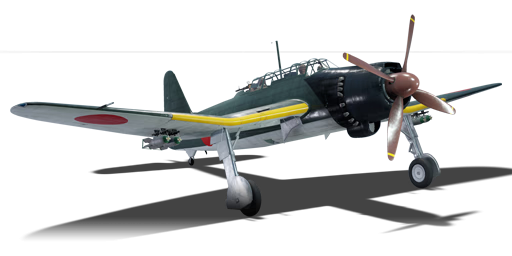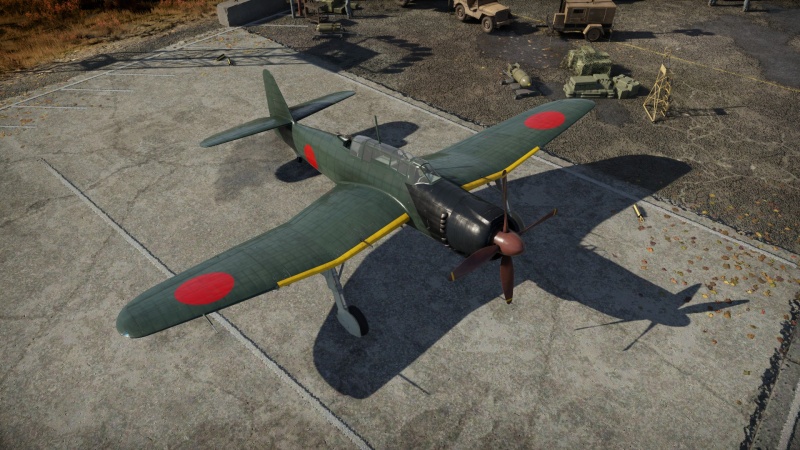B7A2 (Homare 23)
| This page is about the premium Japanese bomber B7A2 (Homare 23). For the regular version, see B7A2. |
Contents
Description
The B7A2 (Homare 23) Ryusei was a prototype to test the new Homare 23 engine on the B7A2 which boasted 200 hp more than the Homare 12 installed on the production line of the B7A2. Other than the engine, the fuselage, wings, and armament haven't changed resulting in an enhanced B7A2 which wasn't able to be mass-produced.
The Ryusei (Homare 23) was introduced in Update "La Royale" as a reward for Battle Pass: Season XII, "Armour Breaking Ambusher". Like its previous production model, the B7A2, it's deceivingly manoeuvrable and has an even stronger engine for the same plane, still lacking any real armour. It can bite back with its defensive 13 mm machine gun or engage frontally with two wing-mounted Type 99 Model 2 cannons. While technically classified as a carrier-borne torpedo bomber, it is very capable of fulfilling the roles of dive-, level-, and torpedo bombing targets. While the max tonnage of bombs doesn't increase over the previous B6N Tenzan, it can carry four additional wing-mounted 60 kg bombs next to its bomb bay that can load two 250 kg or six 60 kg. The main playstyle of the B7A2 is more like an unarmoured attacker, using its arsenal of bombs and cannons on targets either in the sky, on the ground, or on the sea with the deadly precision of its gyrostabilized dive-bomber sight.
- Nicknames
- Official Designation: 流星 (Ryūsei, "Shooting Star")
- Allied reporting name: Grace.
General info
Flight performance
This B7A2 "Ryusei" is equipped with the Nakajima Homare 23 engine, boasting 1,979 horsepower, a significant upgrade over its predecessor, the Homare 12, which had 1,831 horsepower. This enhancement not only addresses the issue of weaker acceleration but also facilitates a higher top speed for the Ryusei. Remarkably, despite the power boost, the aircraft maintains its overall manoeuvrability.
One significant flaw in the manoeuvrability of the Ryusei is its roll rate. While its turn rate, rudder, and elevator authorities are relatively fine, the roll rate is notably stiff. Pilots need to be aware of this characteristic. Simply rolling out of combat is not a straightforward manoeuvre, and to leverage its commendable turn rate, the initiation of the roll should be done as early as possible.
The B7A2's manoeuvrability and acceleration are notably weak when operating below 300 km/h. However, as its speed increases between 300 and 500 km/h, the Ryusei demonstrates impressive agility, often outperforming enemy fighters in turns. With the added boost of WEP, it maintains energy well during manoeuvres, allowing it to effectively pursue adversaries.
Nevertheless, as the Ryusei's velocity surpasses 500 km/h, it begins to experience a gradual loss of control, eventually leading to lockup around 600 km/h. This limitation poses risks, particularly during dive-bombing missions, where failed pull-ups can be fatal. Fortunately, the aircraft's airbrakes offer a solution by restoring control and facilitating safe recovery from dives.
| Characteristics | Max speed (km/h at 6,000 m) |
Max altitude (metres) |
Turn time (seconds) |
Rate of climb (metres/second) |
Take-off run (metres) | |||
|---|---|---|---|---|---|---|---|---|
| AB | RB | AB | RB | AB | RB | |||
| Stock | 566 | 549 | 10000 | 20.5 | 21.4 | 11.9 | 11.9 | 270 |
| Upgraded | 609 | 586 | 19.8 | 20.0 | 18.8 | 14.9 | ||
Details
| Features | ||||
|---|---|---|---|---|
| Combat flaps | Take-off flaps | Landing flaps | Air brakes | Arrestor gear |
| ✓ | ✓ | ✓ | ✓ | ✓ |
| Limits | ||||||
|---|---|---|---|---|---|---|
| Wings (km/h) | Gear (km/h) | Flaps (km/h) | Max Static G | |||
| Combat | Take-off | Landing | + | - | ||
| 680 | 350 | 457 | 428 | 280 | ~15 | ~15 |
| Optimal velocities (km/h) | |||
|---|---|---|---|
| Ailerons | Rudder | Elevators | Radiator |
| < 380 | < 380 | < 450 | > 312 |
Survivability and armour
The B7A2 has a single 13 mm steel plate behind the engine that protects the pilot from head-on attacks. It works well, however the aircraft itself is still very fragile. Although it contains self-sealing fuel tanks, the B7A2 is still vulnerable to catching fire. The tanks in the wing only make the problem worse. The B7A2 should not be involved in combat where it requires the use of the tail gunner. The best strategy is to use evasive manoeuvres because of the plane's good manoeuvrability but poor survivability.
Modifications and economy
Armaments
Offensive armament
The B7A2 (Homare 23) is armed with:
- 2 x 20 mm Type 99 Model 2 cannons, wing-mounted (200 rpg = 400 total)
Suspended armament
The B7A2 (Homare 23) can be outfitted with the following ordnance:
- 10 x 60 kg Navy Type 97 Number 6 bombs (600 kg total)
- 4 x 60 kg Navy Type 97 Number 6 bombs + 2 x 250 kg Navy Type 98 Number 25 bombs (740 kg total)
- 1 x 800 kg Number 80 Mod. 1 bomb (800 kg total)
- 1 x 850 kg Type 91 Model 3 torpedo
Defensive armament
The B7A2 (Homare 23) is defended by:
- 1 x 13 mm Type 2 machine gun, dorsal turret (1,000 rpg)
Usage in battles
The Ryusei is best utilized as a multi-role aircraft, similar to the role the Ju 87 D-5 plays. Once its payload is dropped, the B7A2 becomes a low-altitude dogfighter similar to an A6M, packing deadly 20 mm cannons with a very manoeuvrable airframe and on top of that a stronger engine.
Payload choice is dependent on target choice. For instance, if the target is a light pillbox, one does not need an 800 kg bomb. Instead, equip either of the other bomb loadout options. The same goes for most ground units, apart from arcade mini bases. The Ryusei is similar to aircraft such as the Ki-49-IIa in that it can "hover" above an enemy base or airfield, rapidly dropping its payload and diving up to altitude again. Since the B7A2 is a dive bomber, it does not have to be level to drop its payload accurately. The Ryusei's ability to "hover" above enemy mini bases and airfields can be a great help to any arcade battles team. Upgrading the crew reload speed makes this aircraft a potential game-winner, especially when in a squad.
Having a B7A2 on any team, no matter the game mode, never hurts.
Manual Engine Control
| MEC elements | ||||||
|---|---|---|---|---|---|---|
| Mixer | Pitch | Radiator | Supercharger | Turbocharger | ||
| Oil | Water | Type | ||||
| Controllable | Controllable Not auto controlled |
Controllable Not auto controlled |
Controllable Not auto controlled |
Separate | Controllable 2 gears |
Not controllable |
Pros and cons
Pros:
- B7A for Carrier-based torpedo bomber
- Bomber spawn
- 1 x Type 91 Aerial Torpedo
- Torpedo has the highest drop speed in the game at 580 km/h and is one of the most feared torpedoes in Naval Battles
- 10 x Type 97 No.6 Land Bomb (60kg)
- Gets a bomb bay of 6 x 60 kg bombs which can be used to hit multiple targets (+4 on the wings that drop in pairs)
- 1 x No.80 Land Bomb (800 kg)
- Heaviest bomb Japanese Navy can offer
- Common Navy plane construction:
- Excellent manoeuvrability
- B7A2 (Homare 23) specific
- Airbrakes
- Short take-off and landing distance
- 2 x wing mounted Type 99 Model 2 (20 mm)
- 1 x tail defensive Type 2 (13 mm) with good coverage
Cons:
- B7A for Carrier-based torpedo bomber
- Relatively Large target
- Common Navy plane construction:
- Little armour, and no self-sealing fuel tanks
- Exposed tail gunner
- Easily compress when exceeding 600 km/h
- Mediocre roll rate
- Limited WEP time (only 5 minutes 20 seconds of water injection)
History
Describe the history of the creation and combat usage of the aircraft in more detail than in the introduction. If the historical reference turns out to be too long, take it to a separate article, taking a link to the article about the vehicle and adding a block "/History" (example: https://wiki.warthunder.com/(Vehicle-name)/History) and add a link to it here using the main template. Be sure to reference text and sources by using <ref></ref>, as well as adding them at the end of the article with <references />. This section may also include the vehicle's dev blog entry (if applicable) and the in-game encyclopedia description (under === In-game description ===, also if applicable).
Media
- Skins
- Videos
See also
Links to the articles on the War Thunder Wiki that you think will be useful for the reader, for example:
- reference to the series of the aircraft;
- links to approximate analogues of other nations and research trees.
External links
| Aichi Aircraft Company, Limited (愛知航空機株式会社) | |
|---|---|
| Bombers | D3A1 |
| B7A2 · B7A2 (Homare 23) | |
| Recon | E13A1 |
| Japan bombers | |
|---|---|
| Navy | |
| Carrier-based attack bomber | |
| B5N | B5N2 |
| B6N | B6N1 · B6N2 · B6N2a |
| B7A | B7A2 · B7A2 (Homare 23) |
| Carrier-based dive bomber | |
| D3A | D3A1 |
| D4Y | D4Y1 · D4Y2 · D4Y3 Ko |
| Shipboard Observation seaplane | |
| F1M | F1M2 |
| Land-based Attack bomber | |
| G4M | G4M1 |
| G5N | G5N1 |
| G8N | G8N1 |
| Flying boat | |
| H6K | H6K4 |
| H8K | H8K2 · H8K3 |
| Land-based Bomber | |
| P1Y | P1Y1 |
| Army | |
| Light | Ki-32 |
| Ki-48-II otsu | |
| Heavy | Ki-21-Ia · Ki-21-I hei |
| Ki-49-I · Ki-49-IIa · Ki-49-IIb · Ki-49-IIb/L | |
| Ki-67-I Ko · Ki-67-I otsu | |
| Other countries | ▅B-17E |
| Japan premium aircraft | |
|---|---|
| Fighters | Hagiri's A5M4 · A7He1 · Ki-27 otsu Tachiarai |
| Ki-44-II otsu · ▅Bf 109 E-7 · ▅F4U-1A · Ki-100-II · Ki-44-I 34 | |
| ▅Fw 190 A-5 · A7M1 (NK9H) · Tada's Ki-61-I hei · ▅P-51C-11-NT | |
| J2M4 Kai · A6M5 Ko · A6M6c · J2M5 · Ki-87 · J6K1 | |
| Twin-engine fighters | Ki-96 |
| Jet fighters | F-86F-40 JASDF▅ · T-2 Early · F-4EJ ADTW |
| Bombers | Ki-21-I hei · Ki-48-II otsu · H8K3 · B7A2 (Homare 23) · ▅B-17E |





